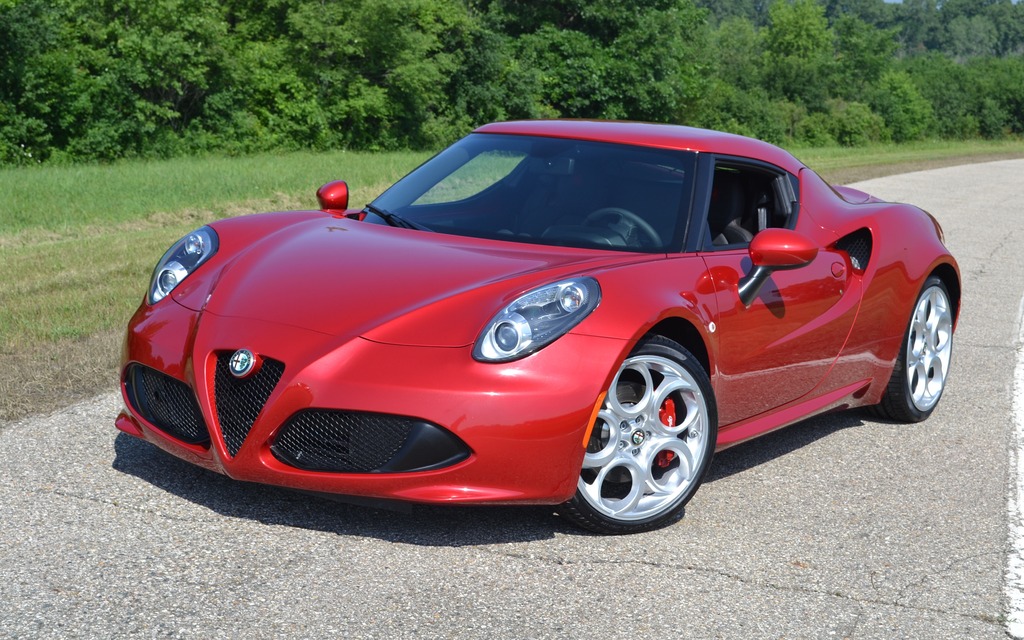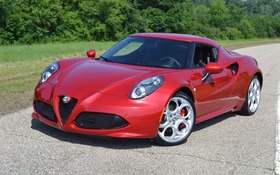Alfa Romeo 4C: A Stranger Among us
They say that there’s a reason for everything in life, even our trials and tribulations. Chrysler certainly felt the brunt of the financial crisis and subsequently went through major restructuring, but the new Fiat management has infused the brand with new flavour, something that probably couldn’t have happened any other way. Not only has this intercultural marriage resulted in a sharing of resources and development strategies, it has also allowed the North American market to enjoy some lovely new Italian vehicles, such as the Fiat 500.
This time, however, it’s the Alfa Romeo 4C that is headed to our continent, much to the delight of performance nuts. To give you a better idea of what it’s all about, the 4C is right up there with the Porsche Cayman and Jaguar F-Type. But the 4C’s philosophy—compact size, small engine displacement and light weight—also reminds us of the speed machines from Lotus. It will certainly stand out in Chrysler showrooms! The 4C will only be sold at four select dealerships in Canada, but you can be sure that they will shine the spotlight on this vehicle.
Noble roots
Not everyone is unfamiliar with the Alfa Romeo brand. It was established in Milan in the early 1900s, and several race models made their mark from the 1920s through to the 1960s. The label then became more well-known but faced financial difficulty and was eventually bought by Fiat Group in 1986. Fiat Group boasts an impressive roster of brands, including Ferrari, Lancia and Maserati.
This explains why the 4C is built in collaboration with Maserati and assembled in Modena, a hotspot for sports cars. Given its roots, we knew the 4C would be a nobleman, but we decided to test it anyway at Chrysler’s development centre in Chelsea, Michigan. And we quickly determined that the 4C lived up to its heritage!
The Alfa Romeo 4C starts at just over $60,000. It’s a mid-engine sports coupe, just like the Sports Cayman. The 4C name refers to its 1.7-litre turbocharged four-cylinder engine, which produces 237 horsepower and an excellent 238 lbs.-ft. of torque, of which 80% is available at 1,700 rpm. This may be less power what its rivals offer, but given that the 4C is lighter on its feet (weighing 400 lbs. less than the Porsche Cayman and 800 lbs. less than a BMW Z4), this vehicle has the advantage.
In fact, lightness is the 4C’s secret. Keeping weight to a minimum was an essential consideration in the vehicle’s development. Thanks to ubiquitous use of carbon fibre, aluminum for the chassis and fibreglass for the body, the 4C tips the scales at a mere 2,315 lbs. (1,050 kilograms). Now that’s something! Unfortunately, all the hard work put in by the car’s engineers is somewhat less appreciable in the North American 4C, which weighs 342 lbs. (155 kg) more than the European model. That’s because of legislation on our side of the Atlantic that calls for extra equipment and other adjustments. What a tragedy! These changes also mess with the 4C’s ideal weight distribution, shifting it to 49/51.
We were surprised to learn that the 4C comes with just one transmission. And it’s not a manual! It’s an automatic twin-clutch transmission (TCT) that sends power to the rear wheels. When you consider how popular manual transmissions are in Europe, you have to wonder why Alfa Romeo didn’t offer other options.
Exquisite exterior
The first thing you’ll notice about this two-seater is its compact size and low profile. It’s short and wide, with proportions that are very different from roadsters such as the Z4. The car’s lines are deliciously exotic, especially in the rear, which is reminiscent of some Ferrari models (i.e. the round tail lights). Its sport aspirations are emphasized by a dual exhaust, massive air diffuser and low bumper. The more exclusive Launch version comes with an additional small spoiler. On the sides, there are air intakes just behind the doors to draw fresh air into the engine. Meanwhile, there are 18-inch wheels in back and 19-inch wheels in front to really underscore the car’s style. The front treatment helps define the brand with a pointed nose and triangular grille. If you’re looking for exotic, you won’t be disappointed. It looks like a small Ferrari.
Inside, the passenger compartment is also a departure from the norm. Forget gadgets and equipment; it’s very minimalist. In an effort to keep the vehicle’s weight down, the interior is very sparse, with a few unusual features, such as leather straps serving as door handles.
Slide into the driver’s seat and you’ll swear that you’re in a race car. The thresholds and lower portions of the doors are very wide and covered in carbon fibre panels. Both the driver and passenger are treated to big aluminum footrests so that you can really brace yourself for sporty driving.
The instrumentation is clear and easy to see , and the centre portion of the dashboard is angled toward the driver. The only aspects that didn’t excite us were the design and feel of the steering wheel. It was also hard to find a good driving position as the seats are not very adjustable. Once the engine has started, you’ll be looking for the gear shifter, but there isn’t one. Instead, there are four metal buttons. The presentation isn’t very intuitive, but it certainly adds to the “race car” effect.
Excellent weight/power ratio
As soon as it starts, the 4C will impress you with the rumble of its engine. Despite its small displacement, the engine can really roar like a Formula 1 car! Italians are known to be experts in “engine acoustics” and they’ve proven themselves once again. We’d buy it for its sound alone! Performance-wise, the four-cylinder’s 237 ponies are not the most eloquent, but the generous torque adds punch. The car’s ultra-compact size and nominal weight make for an excellent weight/power ratio: 4.7 kg/horse. This allows the vehicle to dart from 0 to 100 km/h in less than 4.5 seconds.
This speedster also comes with Alfa DNA (Dynamic, Normal and All Weather), which lets you adjust the road handling using a knob on the centre console. This system varies the response of the accelerator and steering. A fourth mode – Race – is also available to disconnect all driver assistance systems and let you show off your driving abilities. Very few cars offer this amount of latitude nowadays.
The Alfa Romeo will certainly capture the attention of many drivers. Unfortunately, just a select few will actually get their hands on one this year, as few models will make their way to Canadian showrooms.












